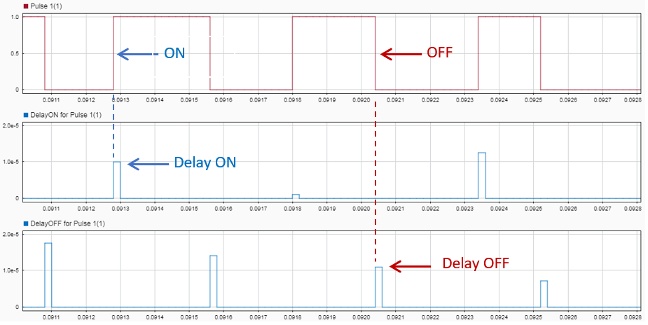PWM Generator (Interpolation)
(To be removed) Carrier-based unipolar PWM generation with interpolation
The Specialized Power Systems library will be removed in R2026a. Use the Simscape™ Electrical™ blocks and functions instead. For more information on updating your models, see Upgrade Specialized Power System Models to use Simscape Electrical Blocks.
Libraries:
Simscape /
Electrical /
Specialized Power Systems /
Power Electronics /
Power Electronics Control
Description
The PWM Generator (Interpolation) block generates pulses for PWM-controlled power electronics converters by using a carrier-based, unipolar PWM method with interpolation.
The block can control switching devices with two-quadrant converters, single-phase full-bridges, two-level three-phase bridges, or three-level three-phase bridges. The reference signal at the Vref port, also called the modulating signal, is compared with a symmetrical triangle carrier. When the reference signal is greater than the carrier, the pulse for the upper switching device is high (1), and the pulse for the lower device is low (0). The generator uses this unipolar modulation technique to control each arm independently. A second reference signal is internally generated by phase-shifting the original reference signal by 180 degrees.
The interpolation method takes into account switching events that occur between the two sample times of the generator and computes the time delays to capture the evolution of the states at different switching times. The block computes the pulse delays sent to the power electronic gate inputs when the Use time stamped gate signals option of the powergui block is enabled.

This figure shows Pulse 1 of the output port
P, delay 1 of the output port
DelayOn and delay 1 of the output
port DelayOff.

Every time the pulse signal enters the on state, DelayOn outputs
a value that corresponds to the exact time delay between the computation step and when
the pulse entered the on state. In the figure, the Pulse 1 signal
enters the on state at 0.09128 seconds (indicated by the blue arrow).
At the same moment, the DelayOn output for Pulse 1 is 1e-5 seconds.
Therefore, the exact time Pulse 1 entered the on state was 0.09128 –
1e-5 = 0.09127 seconds.
Similarly, every time the pulse signal enters the off state,
DelayOff outputs a value that corresponds to the exact time
delay between the computation step and when the pulse entered the off
state. In the figure, Pulse 1 enters the off state at 0.09204 seconds
(indicated by the red arrow). At this moment, the DelayOff output
is equal to 1.09e-5 seconds. Therefore, the exact time Pulse 1 entered the
off state was 0.09204 – 1.05e-5 = 0.0920295 seconds.
This time-stamped interpolation technique works only with the following converter blocks:
Converters built with individual switch blocks
Universal Bridge blocks (for modeling half bridge, full bridge, and two-level three-phase converters)
Three-Level Bridge blocks
For more information on the sampling techniques, see the PWM Generator (2-Level) block reference page.
Ports
Input
Output
Parameters
Extended Capabilities
Version History
Introduced in R2019b
